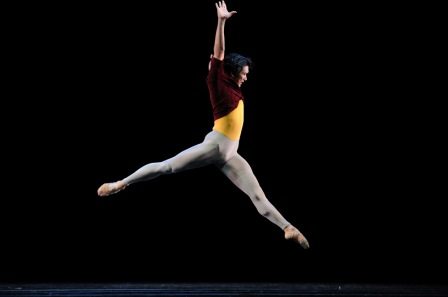

The 12th annual Fall for Dance Festival ran from September 30 – October 11, 2015, with five programs filled with emerging and established artists alike. The performance on Friday, October 9, featured four works, from the Nrityagram Dance Ensemble, San Francisco Ballet, Stephen Petronio Company, and Dorrance Dance.
The Nrityagram Dance Ensemble opened Friday night’s performance with the US premiere of Shivashtakam (An Ode to Shiva), inspired by the Sanskrit poem of the same name written by Adi Shankaracharya. Sirupa Sen, a preservationist of the classical Indian dance form Odissi, begins the piece by reciting the English translation of the poem, which describes the grace and power of Shiva—the cosmic dancer who creates and destroys. Sen performs a tranquil solo and is soon joined by Bijayini Satpathy to music by Pandid Raghunath Panigrahi, commissioned for the piece by Nrityagram. The duet presents a new energy, one of assertiveness and rhythmic expression to contrast Sen’s solo. Precise and articulate, the two execute the movement with exquisite synchronicity and harmony. In each stance, the dancers create a picture of balance.
San Francisco Ballet’s Solo, choreographed by Hans van Manen, is a jovial exhibition of camaraderie and competition between three male dancers: Gennadi Nedvigin, Joseph Walsh, and Hansuke Yamamoto. The movement is dense with seemingly effortless feats of strength and dexterity, yet also humorous: flips of the head incite chuckles from the audience, and the fluid structure of the dance allows us to engage in the playful ballet battle. The music by Bach, as played by violinist Sigiswald Kuijken, adds to the bouncy tone of the solos. In the final sequence the trio dances in unison, building to a final victorious pose of the three—each positioned as a winner.
Locomotor, choreographed by Stephen Petronio, is an exploration of both forward and backward movement through space and time. The Stephen Petronio Company (with special guest Melissa Toogood) executes the challenging steps beautifully (backwards runs, circling steps, movement initiated by the nose), their lines reaching past their own bodies like light beams slicing through the room. Throughout Locomotor we see bodies active in their own space, then becoming interactive and reactive with one another. The ending revisits the backward runs and leaps at the beginning of the piece, as individuals traveling in parallel paths collectively travel backwards.
Fresh off of winning a MacArthur Award, Michelle Dorrance brings Myelination to the stage in its world premiere, commissioned for the Fall For Dance Festival. Dorrance Dance brings ferocity and finesse in this piece inspired by the nervous system. Though choreographed with ingenuity by Dorrance, the piece also features excellent improvisational work by the dancers. These dancers, including Emma Portner and Leonardo Sandoval, are some of the top in the field; the musicians and vocalists also add an exciting layer to the work. Myelination is at times mechanical, sometimes emotional, at times isolating, at others communal. One question that seems to permeate throughout, is how does rhythm move someone? And consequently, how does a body move the rhythm?